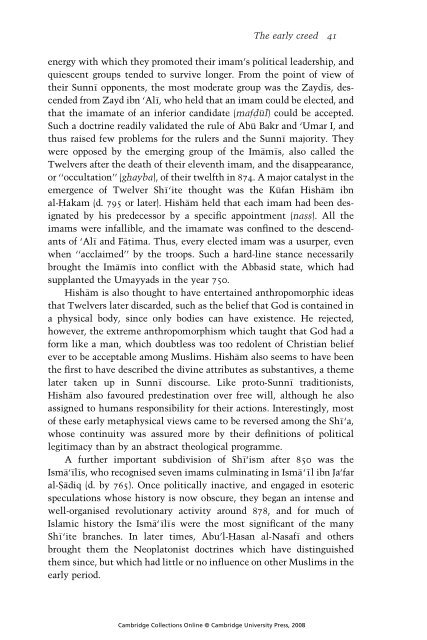Abdal Hakim Murad - The Cambridge Companion to Islamic Theology
You also want an ePaper? Increase the reach of your titles
YUMPU automatically turns print PDFs into web optimized ePapers that Google loves.
<strong>The</strong> early creed 41<br />
energy with which they promoted their imam’s political leadership, and<br />
quiescent groups tended <strong>to</strong> survive longer. From the point of view of<br />
their Sunnı opponents, the most moderate group was the Zaydıs, descended<br />
from Zayd ibn ‘Alı, who held that an imam could be elected, and<br />
that the imamate of an inferior candidate (mafd _<br />
ul) could be accepted.<br />
Such a doctrine readily validated the rule of Abu Bakr and ‘Umar I, and<br />
thus raised few problems for the rulers and the Sunnı majority. <strong>The</strong>y<br />
were opposed by the emerging group of the Imamıs, also called the<br />
Twelvers after the death of their eleventh imam, and the disappearance,<br />
or ‘‘occultation’’ (ghayba), of their twelfth in 874. A major catalyst in the<br />
emergence of Twelver Shı‘ite thought was the Kufan Hisham ibn<br />
al-H _<br />
akam (d. 795 or later). Hisham held that each imam had been designated<br />
by his predecessor by a specific appointment (nas _<br />
s _<br />
). All the<br />
imams were infallible, and the imamate was confined <strong>to</strong> the descendants<br />
of ‘Alı and Fat _<br />
ima. Thus, every elected imam was a usurper, even<br />
when ‘‘acclaimed’’ by the troops. Such a hard-line stance necessarily<br />
brought the Imamıs in<strong>to</strong> conflict with the Abbasid state, which had<br />
supplanted the Umayyads in the year 750.<br />
Hisham is also thought <strong>to</strong> have entertained anthropomorphic ideas<br />
that Twelvers later discarded, such as the belief that God is contained in<br />
a physical body, since only bodies can have existence. He rejected,<br />
however, the extreme anthropomorphism which taught that God had a<br />
form like a man, which doubtless was <strong>to</strong>o redolent of Christian belief<br />
ever <strong>to</strong> be acceptable among Muslims. Hisham also seems <strong>to</strong> have been<br />
the first <strong>to</strong> have described the divine attributes as substantives, a theme<br />
later taken up in Sunnı discourse. Like pro<strong>to</strong>-Sunnı traditionists,<br />
Hisham also favoured predestination over free will, although he also<br />
assigned <strong>to</strong> humans responsibility for their actions. Interestingly, most<br />
of these early metaphysical views came <strong>to</strong> be reversed among the Shı‘a,<br />
whose continuity was assured more by their definitions of political<br />
legitimacy than by an abstract theological programme.<br />
A further important subdivision of Shı‘ism after 850 was the<br />
Isma‘ılıs, who recognised seven imams culminating in Isma‘ıl ibn Ja‘far<br />
al-S _<br />
adiq (d. by 765). Once politically inactive, and engaged in esoteric<br />
speculations whose his<strong>to</strong>ry is now obscure, they began an intense and<br />
well-organised revolutionary activity around 878, and for much of<br />
<strong>Islamic</strong> his<strong>to</strong>ry the Isma‘ılıs were the most significant of the many<br />
Shı‘ite branches. In later times, Abu’l-H _<br />
asan al-Nasafı and others<br />
brought them the Neopla<strong>to</strong>nist doctrines which have distinguished<br />
them since, but which had little or no influence on other Muslims in the<br />
early period.<br />
<strong>Cambridge</strong> Collections Online © <strong>Cambridge</strong> University Press, 2008



